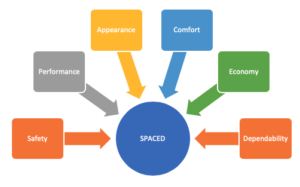Relationship Selling- A Tool for Improving Your Presentation
Relationship Selling- A Tool for Improving Your Presentation
Guest writer Floyd Jerkins joins us today for another article on relationship selling. This time viewing relationship selling as a tool for improving your presentation.
Since you are following my articles on Relationship Selling, by now you’re starting to get it that I believe in following a system. That doesn’t mean every sale made is templated. It does mean that the more times you can follow a system, your closing ratio goes up.
Practice the Fundamentals Before Engaging Customers
Feedback from master salespeople who do an honest evaluation of their sales strategies often mentions that reviewing the fundamentals before creating an advanced approach just makes sense. Why do professional NBA or NFL or any other professional team work on fundamentals at every practice? They practice on the sidelines, not on customers. They work on the fundamentals.
The Chair Salesperson
Let’s say you are selling chairs. You meet the customer in the aisle after giving them a few minutes to roam the store. You start with an opening line, Welcome to our store; how may I be of service? Of course, the answers could go a few different ways so let’s say they are looking for chairs.
You are into the Qualifying stage of the sales process. Too many salespeople will start by sharing what chairs are for sale, how many they have, and where they are in the store. A professional furniture salesperson starts by asking questions about why they want a chair, what they have now, what different features they are looking for, etc. You build rapport through questions and showing a sincere interest in the customer.
Through this stage, you’ve learned that your customer loves their grandchildren, has a bad lower back, likes to rock in a chair, and doesn’t like leather. Ok, great, now you have something to talk about that’s important to the customer.
What is important to the store manager is that inventory turns. What’s important to the salesperson who is on commission is that they sell a chair today. But none of what’s important to the store manager or the salesperson is valuable to the customer.
In the presentation stage, what do you present about the chair that you’ve selected for the customer? You wouldn’t pick a leather chair that doesn’t rock just because it’s the one on sale or the one your manager told you to sell today, would you? You’d present the chair with the customers’ needs in mind, wouldn’t you? I hope the answer is yes!
Customer Expectations
During the first few steps in the sales process, the customer expects the salesperson to ask questions. It’s a normal process. By using this opportunity to explore, you learn about the buying motives, who the buyer and decision-makers are, how they want to pay for it, how much down payment, and just about anything else you want to know. If you are into the closing stage and asking the customer how much down payment they have, you are well on your way to being an average salesperson and will make an average income and live an average life.
As you ask questions to learn, make notes. Don’t be afraid that you should remember everything. A good salesperson may talk with several people in person and over the phone every day. Good note-taking is an essential part of time management. I cover those subjects in other articles.
Working Smart: Tools of the Trade
A professional technician who works on cars has a large toolbox with many drawers. Each drawer contains a tool that’s used for a certain purpose. A good tech won’t use a crescent wrench when they need a 5/8-line wrench. A great salesperson uses selling tools in the same way. There are tools of the trade that help to close more sales in less time. Use them well, and they will make you money and create a lifetime of customers. Don’t use them, and you will struggle with making sales and a significant income.
In teaching sales and sales managers, I always tried to make it easy to learn new ideas. Now, this isn’t always easy, but using acronyms always helps with retention.
The SPACED analogy is a tool. Here is how this works.
Mr. Customer, you’ll notice that the chair rocks but it won’t tip over because of the extra flange on the backside of the platform. That’s a perfect safety feature to prevent you from overturning the chair when you’re rocking your grandchildren you mentioned. Will that feature become valuable to you?
Mr. Customer, you mentioned (while we were in the qualifying stage of the sales process) that you preferred cloth over leather. This particular chair has a cloth velour that is easily cleaned and won’t stain. The appearance of this will last for years and years. Does that type of feature interest you?
Mr. Customer, please notice the adjustable lumbar support in lower part of the seat. That has a wide range of adjustments to custom fit to a person’s backside. You mentioned you’ve had some back problems, does this type of feature sound important to you to improve comfort?
Ok, see how the spaced concept works? When you are in the qualifying stage asking questions, you want to learn what the hot buttons are. By keeping the spaced concept in mind, you pick these up and can use them during the presentation.
When you present your product through what you learned the customers wants or needs are, it’s like magic. You soon learn if you are on the right product. Now, pay attention, we’re not even talking about price here are we? If everything is right for the customer, the price is still important, but not the most important. You are building value.
Note that after every explanation of a feature I ask the customer a question to validate that the feature is what they wanted or that it is important to them. Why do this? What you don’t want to do is make an ineffective presentation by covering too much detail when the customer might not want it. You also want to make sure that you are getting buy in from the customer as you explain key features of your product or service before moving on to the next feature.
In closing…
By systemically asking these questions before moving on to the next feature, you are learning if you are on the right track or if you need to make a course correction with a different product. You are building value.


